![]()
![]()
![]()
Use LEFT and RIGHT arrow keys to navigate between flashcards;
Use UP and DOWN arrow keys to flip the card;
H to show hint;
A reads text to speech;
30 Cards in this Set
- Front
- Back
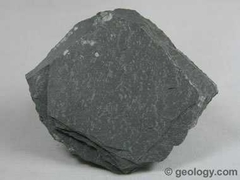
|
Slate, Slate is a fine-grained, foliated, homogeneous metamorphic rock derived from an original shale-type sedimentary rock composed of clay or volcanic ash through low-grade regional metamorphism. It is the finest grained foliated metamorphic rock. |
|

|
Marble, Marble is a metamorphic rock that forms when limestone is subjected to the heat and pressure of metamorphism. It is composed primarily of the mineral calcite (CaCO3) and usually contains other minerals, such as clay minerals, micas, quartz, pyrite, iron oxides, and graphite. Under the conditions of metamorphism, the calcite in the limestone recrystallizes to form a rock that is a mass of interlocking calcite crystals. |
|
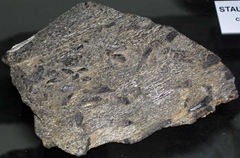
|
Garnet Mica Schist, Schist is a foliated metamorphic rock made up of plate-shaped mineral grains that are large enough to see with an unaided eye. It usually forms on a continental side of a convergent plate boundary where sedimentary rocks, such as shales and mudstones, have been subjected to compressive forces, heat, and chemical activity. |
|
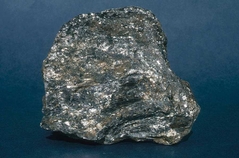
|
Mica Schist, Schist is a foliated metamorphic rock made up of plate-shaped mineral grains that are large enough to see with an unaided eye. It usually forms on a continental side of a convergent plate boundary where sedimentary rocks, such as shales and mudstones, have been subjected to compressive forces, heat, and chemical activity. |
|

|
Gneiss, Gneiss is a common and widely distributed type of metamorphic rock. Gneiss is formed by high temperature and high-pressure metamorphic processes acting on formations composed of igneous or sedimentary rocks. Orthogneiss is gneiss derived from igneous rock. Paragneiss is gneiss derived from sedimentary rock. |
|
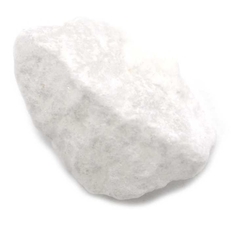
|
Rock Gypsum, chemically precipitated sedimentary rock |
|
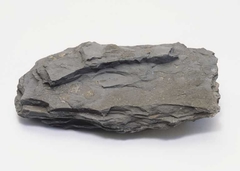
|
Shale, shale is a fine-grained, clastic sedimentary, fissile rock composed of mud that is a mix of flakes of clay minerals and tiny fragments of other minerals, especially quartz and calcite. Shale is characterized by breaks along thin laminae or parallel layering or bedding less than one centimeter in thickness, called fissility |
|
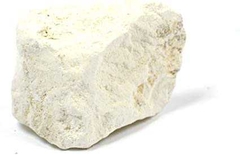
|
Chalk, Chalk is a soft, white, porous, chemically sedimentary carbonate rock, a form of limestone composed of the mineralcalcite. Calcite is an ionic salt called calcium carbonate or CaCO3. It forms under reasonably deep marine conditions from the gradual accumulation of minute calcite shells (coccoliths) shed from micro-organisms called coccolithophores. |
|
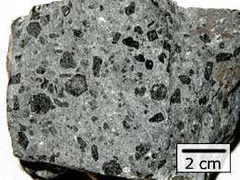
|
Andesite Porphory, is an extrusiveigneous, volcanic rock, of intermediate composition, with aphanitic to porphyritic texture. In a general sense, it is the intermediate type between basalt and rhyolite, and ranges from 57 to 63% silicon dioxide(SiO2) as illustrated in TAS diagrams |
|
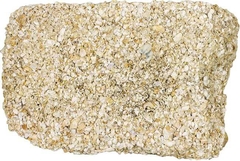
|
Coquina, Coquina is a sedimentary rock that is composed either wholly or almost entirely of the transported, abraded, and mechanically-sorted fragments of the shells of molluscs, trilobites, brachiopods, or other invertebrates. The term coquina comes from the Spanish word for "cockle" and "shellfish". |
|
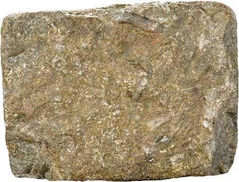
|
Dense Limestone, Limestone is a sedimentary rock composed primarily of calcium carbonate (CaCO3) in the form of the mineral calcite. It most commonly forms in clear, warm, shallow marine waters. It is usually an organic sedimentary rock that forms from the accumulation of shell, coral, algal, and fecal debris. |
|
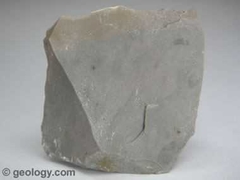
|
Chert, Chert is a hard, fine-grained sedimentary rock composed of crystals of quartz that are very small. Quartz is the mineral form of silicon dioxide. Chert is often of biological origin but may also occur inorganically as a chemical precipitate or a diagenetic replacement. |
|
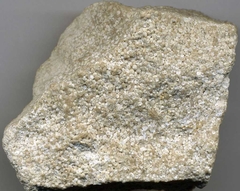
|
Oolitic Limestone, Oolite or oölite is a sedimentary rock formed from ooids, spherical grains composed of concentric layers. The name derives from the Ancient Greek word ᾠόν for egg. Strictly, oolites consist of ooids of 0.25–2 millimetres' diameter; rocks composed of ooids larger than 2 mm are called pisolites |
|
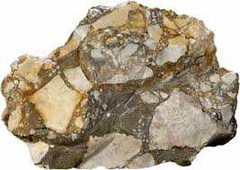
|
Breccia, sedimentary, clastic, coarse grained |
|
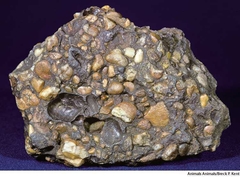
|
Conglomerate, Conglomerate is a coarse-grained clastic sedimentary rock that is composed of a substantial fraction of rounded to subangular gravel-size clasts, e.g., granules, pebbles, cobbles, and boulders, larger than 2 mm in diameter. Conglomerates form by the consolidation and lithification of gravel. |
|
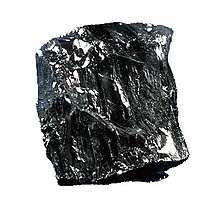
|
Coal, Coal is a combustible black or brownish-black sedimentary rock, formed as rock strata called coal seams. Coal is mostly carbon with variable amounts of other elements; chiefly hydrogen, sulfur, oxygen, and nitrogen.[1] Coal is formed if dead plant matterdecays into peat and over millions of years the heat and pressure of deep burial converts the peat into coal. |
|

|
Peat, Peat forms when plant material, usually in marshyareas, is inhibited from decaying fully by acidic and anaerobic conditions. It is composed mainly of marshland vegetation: trees, grasses, fungi, as well as other types of organic remains, such as insects, and animal remains. Under certain conditions, the decomposition of the latter (in the absence of oxygen) is inhibited. |
|
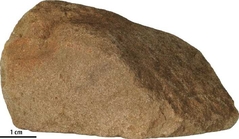
|
Sandstone, Sandstone is a medium grained clastic sedimentary rock composed mainly of sand-sized mineral particles or rock fragments. Most sandstone is composed of quartz or feldspar because they are the most resistant minerals to weathering processes at the Earth's surface, as seen in Bowen's reaction series. |
|
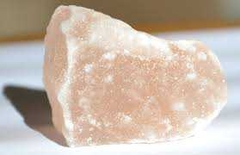
|
Rock Salt, Rock Salt is a chemical sedimentary rock that forms from the evaporation of ocean or saline lake waters. It is also known by the mineral name "halite". It is rarely found at Earth's surface, except in areas of very arid climate. |
|
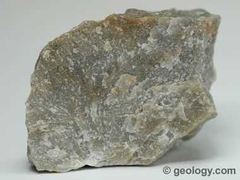
|
Quartzite, Quartzite is a hard, non-foliated metamorphic rock which was originally pure quartz sandstone. Sandstone is converted into quartzite through heating and pressure usually related to tectonic compression within orogenic belts. |
|
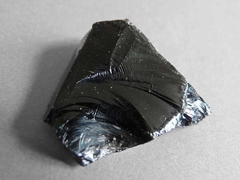
|
Obsidian, Obsidian is a naturally occurring volcanic glass formed as an extrusive igneous rock. Obsidian is produced when felsic lava extruded from a volcano cools rapidly with minimal crystal growth. |
|
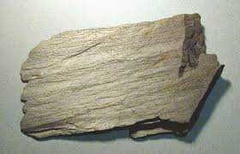
|
Phylite, Phyllite is a type of foliated metamorphic rock created from slate that is further metamorphosed so that very fine grained white mica achieves a preferred orientation. It is primarily composed of quartz, sericite mica, and chlorite. |
|
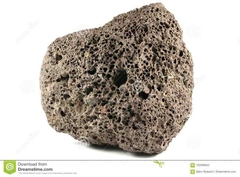
|
Scoria, Scoria is a highly vesicular, dark colored volcanic rock that may or may not contain crystals. It is typically dark in color, and basaltic or andesitic in composition. |
|
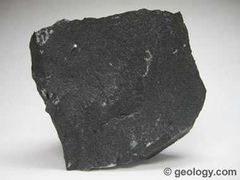
|
Basalt, Basalt is a mafic extrusive igneous rock formed from the rapid cooling of magnesium-rich and iron-rich lava exposed at or very near the surface of a terrestrial planet or a moon. More than 90% of all volcanic rock on Earth is basalt. |
|

|
Pumice, Pumice, called pumicite in its powdered or dust form, is a volcanic rock that consists of highly vesicular rough textured volcanic glass, which may or may not contain crystals. It is typically light colored. |
|
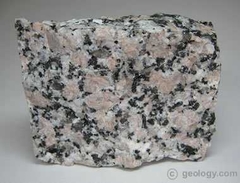
|
Granite, Granite is a common type of felsic intrusive igneous rock that is granular and phaneritic in texture. Granites can be predominantly white, pink, or gray in color, depending on their mineralogy. |
|
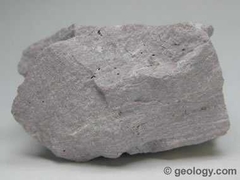
|
Rhyolite, Rhyolite is an igneous, volcanic rock, of felsic composition. It may have any texture from glassy to aphanitic to porphyritic. The mineral assemblage is usually quartz, sanidine and plagioclase. Biotite and hornblende are common accessory minerals. It is the extrusive equivalent to granite. |
|

|
Diorite, Diorite is an intrusive igneous rock composed principally of the silicate minerals plagioclase feldspar, biotite, hornblende, and/or pyroxene. The chemical composition of diorite is intermediate, between that of mafic gabbro and felsic granite. |
|
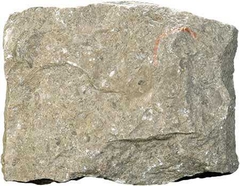
|
Crystalline Limestone, Limestone is a sedimentary rock which is often composed of the skeletal fragments of marine organisms such as coral, foraminifera, and molluscs. Its major materials are the minerals calcite and aragonite, which are different crystal forms of calcium carbonate |
|
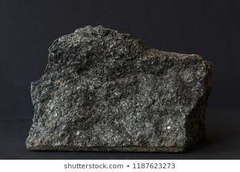
|
Gabbro, Gabbro is a phaneritic, mafic intrusive igneous rock formed from the slow cooling of magnesium-rich and iron-rich magma into a holocrystalline mass deep beneath the Earth's surface. Slow-cooling, coarse-grained gabbro is chemically equivalent to rapid-cooling, fine-grained basalt. |

